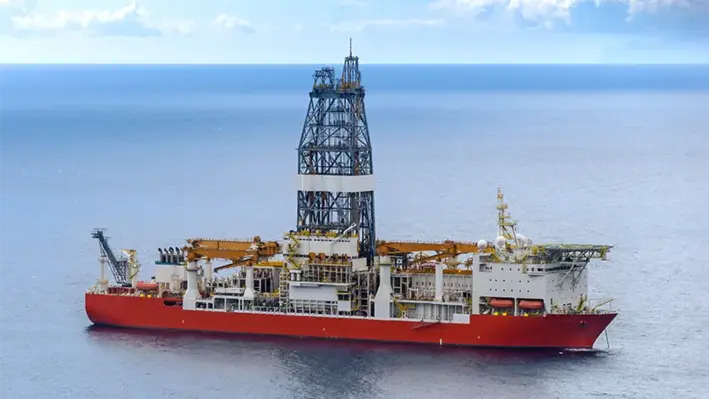
 Hanwha Drilling's new deepwater drillship under Hanwha Ocean's banner is now known as the Tidal Action, following its naming ceremony in South Korea.
Hanwha Drilling's new deepwater drillship under Hanwha Ocean's banner is now known as the Tidal Action, following its naming ceremony in South Korea.
Designed to reach drilling depths of up to 12,000 m in waters running 3,600 m deep, the Tidal Action is gearing up to serve Constellation Oil Services and Petrobras offshore Brazil, where drilling operations are set to start before the year ends. The dynamically positioned vessel can support 20,000-psi blowout preventers (BOPs). It is equipped with DP3-certified thrusters, generous deck space, and load capacities, along with dual derricks to support heavy drilling activity and efficiency.
Considering its "history of operational performance, quality people and excellent relationships with its customers", Hanwha Drilling has partnerered with Constellation who will be managing the Tidal Action drillship for Petrobras. Hanwha Drilling acknowledges the contract as a milestone for the company and an ideal fit for Tidal Action, given the scope of work and timing.
Besides Tidal Action, the Laguna Star drillship which belongs to Constellation's fleet will also be deployed for Petrobras. Ready for operation following necessary adjustments and inspection, the Laguna Star vessel will be capable of drilling in water depths of up to 10,000 feet, with a drilling depth capacity of up to 40,000 feet.
The 2012-built sixth-generation Laguna Star ultra-deepwater DP drillship was constructed at Samsung Heavy Industries shipyard in South Korea.
To know more about the well lifecycle scene in Latin America, click here.
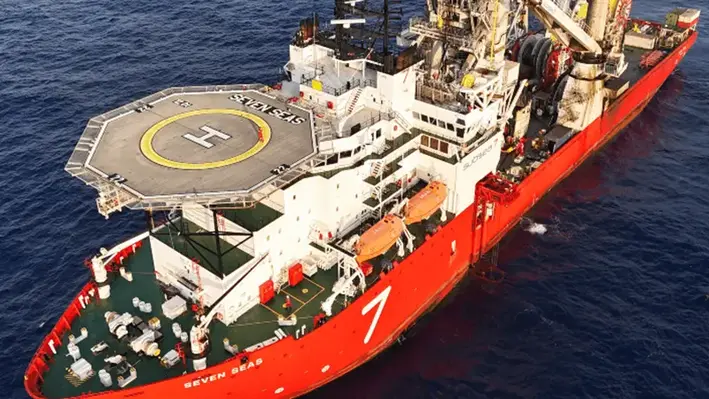
 The Sparta deepwater development in the United States will be spearheaded by Subsea7 as the project's operator Shell Offshore Inc onboarded the subsea engineering and construction company for a sizeable contract, ranging somewhere between US$50-150mn.
The Sparta deepwater development in the United States will be spearheaded by Subsea7 as the project's operator Shell Offshore Inc onboarded the subsea engineering and construction company for a sizeable contract, ranging somewhere between US$50-150mn.
The contract mandates Subsea7 to oversee the transportation and installation of a floating production system (FPS) at Garden Banks block 959, which is located off the southeastern coast of Louisiana at water depths of up to 1,635 metres. The company's team have initiated project management and engineering activities from its office in Houston, Texas, aiming to start offshore operations in 2027.
Craig Broussard, Senior Vice President for Subsea7 Gulf of Mexico, said, “We are proud to continue our collaboration with Shell in the US, building on past projects, including the recent Vito development. We look forward to playing a key role in the successful delivery of the Sparta project.”
Partners involved in the Sparta project has conducted studies to find an estimated, discovered recoverable resource volume of 244 mn barrel of oil equivalent (boe), and is aiming to extract as much as 90,000 boepd. It is Shell’s 15th deep-water host in the Gulf of Mexico. Speaking of the project, the company's Integrated Gas & Upstream Director, Zoe Yujnovich said it "demonstrates the power of replication, driving greater value from our advantaged positions”. It is “aligned with our commitment to pursue the most energy-efficient and competitive projects while supplying safe, secure energy supplies today and for decades to come”.
To know more about Offshore Network's global well lifecycle conferences, click here.
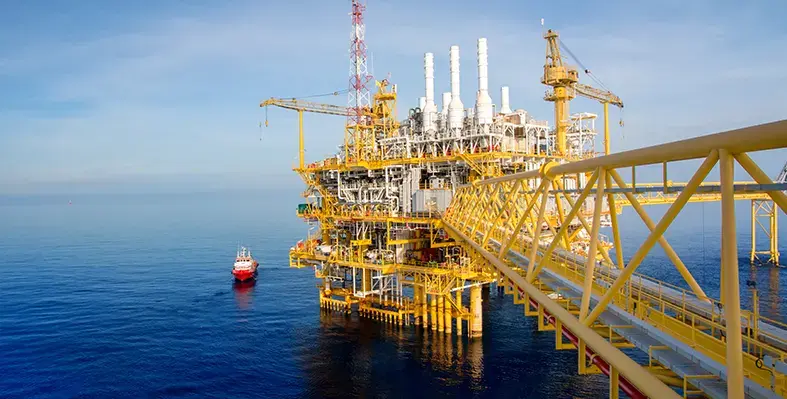
 Nigeria is increasingly looking towards developing its brownfield assets to boost production.
Nigeria is increasingly looking towards developing its brownfield assets to boost production.
This can be achieved with the right technological interventions, giving way to enhanced oil recovery that can substantially meet the region's refining capacity. Compared to greenfield projects that require considerable investments from scratch, brownfield developments cuts down on carbon footprints, thus allowing operators to meet their sustainability requirements. Ideal technological interventions comprise a package offering e-line, slick line, coiled tubing services, well remediation, well control, and idle well management services. Well intervention operations can range from well conversion, casing run operation on a wild cat well, slot recovery, installation of emergency casing head housing slip, well work-over, and drilling and completion, to name a few.
To facilitate more brownfield developments, the Nigerian administration is working to increase collaboration between the local communities, government and the private sector.
Recently, Nigeria-based offshore construction company called Intrepid Energy Limited joined hands with United Kingdom's Aquaterra Energy to deliver a bespoke subsea well intervention equipment package for a project in Nigeria.
“Working with Aquaterra Energy marks a significant step forward for our intervention operations in Nigeria. Their specialised technology enhances our ability to execute intervention programmes efficiently, maximising performance across our assets. By combining Aquaterra’s technical expertise with our deep understanding of the local operating environment, we’re confident this collaboration will enhance production outcomes and create lasting value for our operations in the region,” said Seun Alonge, CEO at Intrepid Energy Limited.
To know more about the well intervention scene in West Africa, click here.
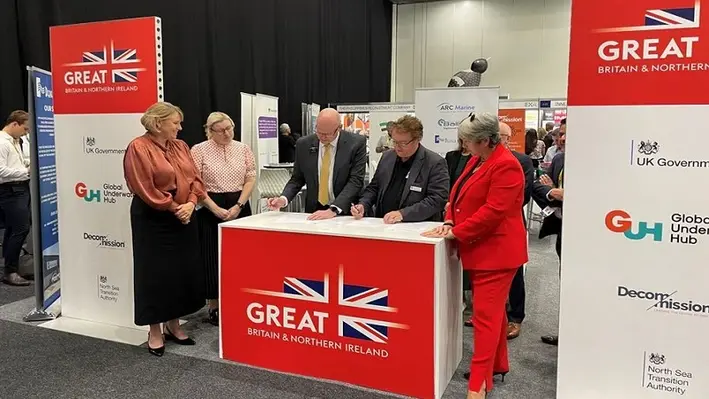
 Global Underwater Hub (GUH) and Subsea Innovation Cluster Australia (SICA) have signed an MoU to collaborate over the development of the subsea sector in both hemispheres.
Global Underwater Hub (GUH) and Subsea Innovation Cluster Australia (SICA) have signed an MoU to collaborate over the development of the subsea sector in both hemispheres.
Under the agreement, the organisations will actively promote opportunities for their subsea supply chains in both countries and share market intelligence and learnings around diversification strategies for the energy transition and defence operation.
GUH Chief Executive, Neil Gordon, said, “Australia has a broad conventional energy mix with strong ambitions towards net zero […] crucially, and similar to the UK, Australia champions a just transition which builds in energy resiliency and security with opportunities in sustained oil and gas production, decommissioning and carbon capture.”
Gordon also highlighted the continued production within the oil and gas industry within Australia where there are opportunities within new developments as well as in the expansion oil current production by leading operators including Woodside and Santos.
He added, “Decommissioning is a significant opportunity in Australia where the inventory of subsea assets requiring to be decommissioned includes over 1,500 wells and structures and 4,500km of pipelines with major opportunities for specialist plugging, cutting, inspection and recovery technologies.”
SICA Cluster Manager, Colin McIvor, commented, “This MoU marks an important step in strengthening collaboration between Australia and the UK’s subsea sectors. By working with GHU, we’re opening new opportunities for innovation, knowledge sharing, and international market access for SICA members. Both organisations bring unique strengths: SICA’s agility and cross-sector innovation focus and GUH’s depth of experience and established global networks. By sharing these, we can deliver real impact for established and emerging industries and accelerate significant growth for both countries.”
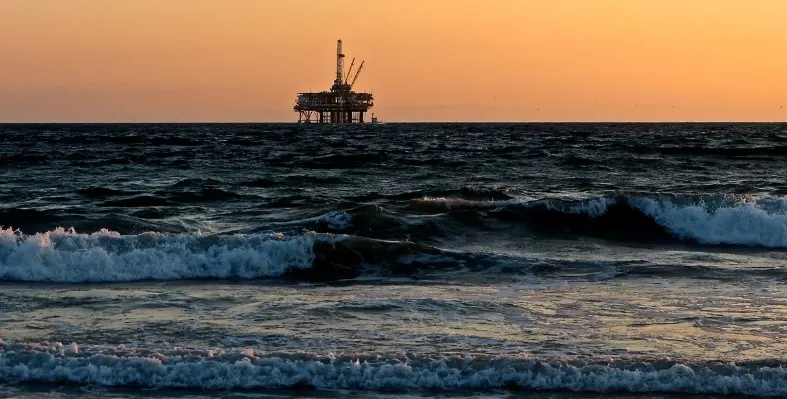

A US federal judge struck down a vast lease sale for drilling rights in the Gulf of America, casting doubt over future oil well interventions in the region.
According to various news reports, the judge ruled that Lease Sale 261, held by the Biden Administration, violated environmental regulations, halting activities across more than 283,280 sq km of federal waters.
Organised by the Bureau of Ocean Energy Management (BOEM), the sale had auctioned off approximately 6,475 sq km for US$261.7mn.
The oil and gas lease sale was located in Gulf waters off the coast of Louisiana, and could threaten the survival of the endangered Rice’s whale species, according to environmental groups.
Statistics have placed the number of whales to just below 100 individuals.
Companies such as Chevron, ExxonMobil, and Shell secured leases aimed at boosting production in the Gulf, which supplies 14% of US crude oil, according to the US Energy Information Administration. However, environmental organisations, including Earthjustice and Sierra Club, challenged the sale, claiming it disregarded climate change consequences and risks to the endangered Rice’s whale.
The judge's decision hinged on the National Environmental Policy Act, finding that BOEM failed to properly evaluate the greenhouse gas emissions tied to future oil and gas output. The judge highlighted potential dangers from vessel strikes and noise pollution caused by drilling, deeming BOEM’s environmental analysis inadequate.
The ruling disrupts plans for oil well interventions and new subsea developments. Those projects are now in jeopardy, with the industry awaiting a resolution that could involve a revised review or cancellation of the leases entirely.
Associated Press added that The American Petroleum Institute, or API, an oil and gas trade association representing more than 600 firms and a party to the Gulf Coast case, said it is evaluating its options after this week’s ruling.
Negotiations to determine next steps are underway, but the immediate impact is clear, as billions in investments and planned interventions in the Gulf hang in the balance, leaving operators scrambling to adapt.
As the legal wrangle continues, the ruling underscores the growing tension between energy demands and environmental protection, with the Gulf of America at the centre of the debate.
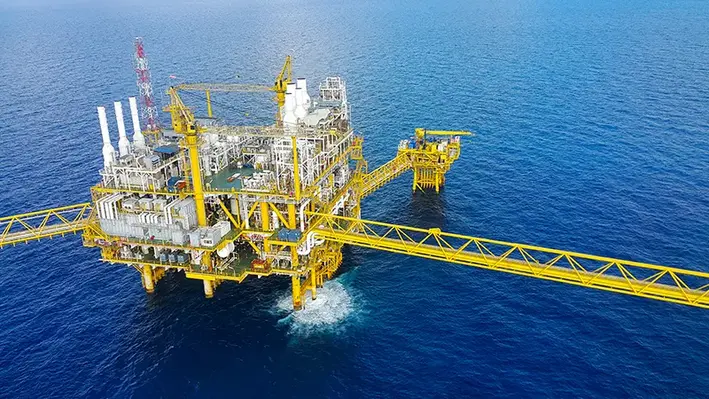
 Petrofac’s Asset Solutions division has secured a series of new contracts and scope expansions in the first quarter of 2025, amounting to US$500mn.
Petrofac’s Asset Solutions division has secured a series of new contracts and scope expansions in the first quarter of 2025, amounting to US$500mn.
These awards reflect the company’s growing presence in key markets and emerging geographies, spanning late-life asset management, decommissioning, and integrated services.
The contracts, awarded across the UK, Europe, the Middle East, Africa, Asia Pacific, and the US, bolster Petrofac’s footprint in established sectors while driving expansion into targeted regions. This significant momentum builds on a strong performance in 2024, reinforcing the company’s strategic vision.
Chief Operating Officer John Pearson commented on the achievement, stating, “Following a strong year for awards in 2024, our Asset Solutions business has had a great start to 2025 with half a billion dollars’ worth of scopes and contract expansions secured already, and a strong pipeline of opportunities across a range of geographies during the remainder of the year.”
Highlighting Petrofac’s expertise, Pearson added, “These awards, with a range of clients, demonstrate the strength in our mature asset management and decommissioning offering, and form part of our strategy to expand our services into selected new geographies. We look forward to continuing this trajectory throughout the remainder of 2025 and beyond.”
This announcement follows Petrofac’s Emirates subsidiary securing an engineering, procurement, and construction (EPC) contract with ADNOC Gas in January 2025. Valued at US$335mn, the deal covers new compression facilities for the Habshan Complex, reinforcing Petrofac’s role in critical infrastructure projects.

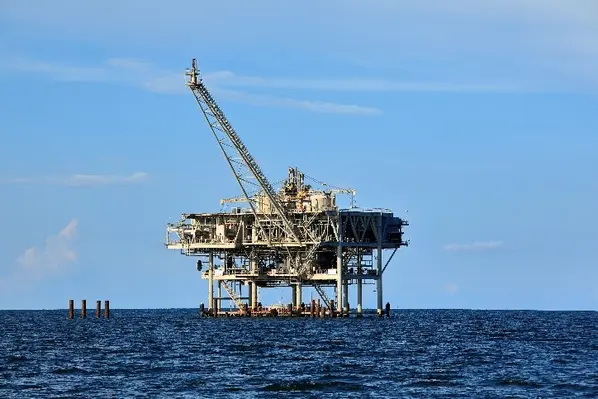 Managing Director at Eye-bot Aerial Solutions, David Palmerton, has analysed the current decommissioning ambit within the Gulf of America, the challenges posed by the vast scope of end-of-life work to carry out, and how robotics and data-driven technologies play an integral role in transforming the market.
Managing Director at Eye-bot Aerial Solutions, David Palmerton, has analysed the current decommissioning ambit within the Gulf of America, the challenges posed by the vast scope of end-of-life work to carry out, and how robotics and data-driven technologies play an integral role in transforming the market.
In the Gulf of America, a significant number of offshore oil and gas wells and platforms are overdue for decommissioning. According to the Bureau of Safety and Environmental Enforcement (BSEE), there are 1,366 offshore structures, with 273 having submitted decommissioning applications and 451 located on terminated leases, of which only 192 have pending decommissioning applications. These delays pose environmental risks, including potential leaks, structural failures, and threats to marine ecosystems as well as increased costs for operators and regulators.
The financial burden of decommissioning these structures is substantial, potentially reaching billions of dollars, with concerns that taxpayers may ultimately bear the cost if companies fail to meet their obligations. A significant portion of these wells are classified as orphaned or abandoned, meaning the companies responsible for their decommissioning no longer exist or lack the financial capability to carry out the required work.
Under regulations set out by the Interior Department, administered by BOEM and BSEE, operators are jointly and severally liable for decommissioning obligations. Even if a company transfers its lease to another operator, it remains responsible for ensuring that all abandonment and removal obligations are fulfilled. Operators must complete decommissioning within one year of lease termination or within three to five years of a structure becoming idle. However, with aging infrastructure and a backlog of overdue removals, BSEE has emphasised the need for proactive compliance throughout the life of a lease.
Given the magnitude of overdue decommissioning in the Gulf, oil and gas operators are turning to advanced technology to enhance pre-decommissioning inspections and streamline project planning. Drones, robotics, and AI-powered digital modelling are now at the forefront of assessing the structural integrity of offshore platforms, pipelines, and subsea infrastructure before decommissioning begins.
By deploying aerial and underwater drones, operators can conduct high-resolution LiDAR scans, ultrasonic inspections, and photogrammetry surveys without sending personnel into hazardous environments. These drone-based inspections provide real-time structural data, detecting corrosion, metal fatigue, and structural integrity risks before dismantling begins.
Simultaneously, AI-driven Building Information Modelling (BIM) and Simultaneous Localised and Mapping (SLAM)-based 3D mapping allow engineers to simulate decommissioning scenarios, optimise removal sequences and enhance worker safety.
The integration of data-driven decommissioning is reshaping offshore well abandonment practices, making projects safer, more efficient, and cost-effective. With thousands of overdue structures requiring removal, these technological advancements offer a critical solution for tackling the Gulf's growing decommissioning backlog.
The process begins with autonomous aerial and underwater drones conducting high-resolution scans of the platform. These drones are equipped with LiDAR, thermal imaging, and photogrammetry sensors, capable of capturing structural details down to the millimetre. The data collected is processed using SLAM technology, generating a real-time digital twin of the platform.
This BIM model provides:
For areas of the platform that are potentially unsafe for human entry, such as confined interiors or corroded sections, a quadruped robotic system is deployed. This autonomous robotic platform is equipped with a LiDAR camera, thermal sensors, and AI-driven navigation, allowing it to traverse hazardous environments, capture high-resolution scans and transmit critical data to the BIM model.
By integrating robotic mobility solutions, teams can inspect structural conditions without exposing personnel to risk, ensuring a complete and accurate dataset for decommissioning planning.
The digital twin model allows engineers to simulate decommissioning scenarios before physical execution, ensuring a safe and efficient process. Potential structural instabilities can be identified, allowing engineers to plan necessary reinforcement measures before deconstruction.
Key considerations for deconstruction planning include:
The decommissioning process is executed with robotic precision, leveraging drones, autonomous robotics and AI-driven modelling.
Some of the execution processes include:
A number of positive results can come from AI-driven decommissioning processes, including a 40% reduction in project time, enhanced worker safety, greater compliance with both regulatory and environmental standards, and increased material recycling and disposal.
As drone technology, AI-driven modelling, and autonomous robotics advance, offshore platform decommissioning is shifting toward zero-contact, data-driven precision. The integration of real-time digital twin modelling, predictive analytics, and autonomous robotic inspections marks the beginning of a fully AI-driven offshore decommissioning era.
This article was authored by David Palmerton, Managing Director at Eye-bot Aerial Solutions.
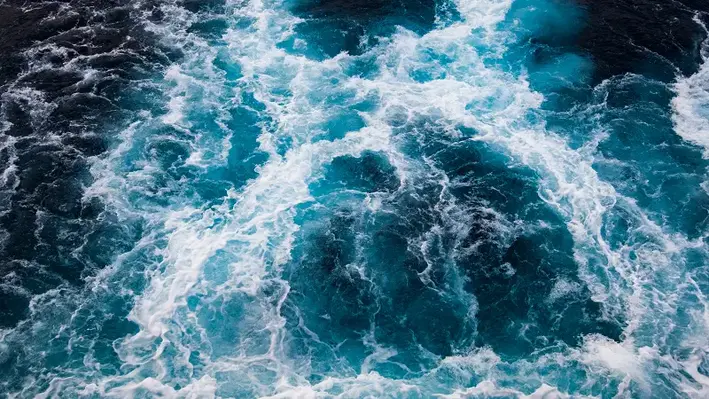
 Constellation Oil Services Holiday (Constellation) has won a new contract with Petrobras for the deployment of a jackup drilling rig for a P&A campaign in the shallow waters of four Brazilian basins.
Constellation Oil Services Holiday (Constellation) has won a new contract with Petrobras for the deployment of a jackup drilling rig for a P&A campaign in the shallow waters of four Brazilian basins.
The agreement has a total value of US$170mn for P&A work in the Sergipe, Alagoas, Ceará and Potiguar basins being carried out by the Admarine 51 rig. The rig will be run and operated by Constellation, which will have up to 210 days to mobilise the rig from its current location in Bahrain to the Brazilian waters, where it will remain for 1,143 days (over three years) with the option to extend up to 472 days.
Rodrigo Ribeiro, CEO of Constellation, said, “We are excited to announce the signing of this new contract, marking our strategic return to shallow water operations and our entry into a promising market segment. This project is the second third-party owned asset to be operated by Constellation, aligning with our core competencies as Drilling Contractors and playing a vital role in Petrobras' ambitious decommissioning plans. The initiative will progress in stages, commencing with the P&A of a significant number of wells currently connected to these fixed platforms.”
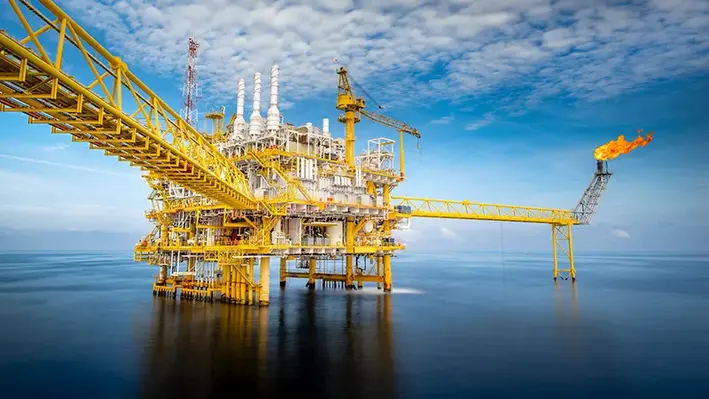
 Archer has announced that Equinor has awarded the company the planning work for the permanent plug and abandonment (P&A) of the Snorre UPA and Heidrun B&C templates.
Archer has announced that Equinor has awarded the company the planning work for the permanent plug and abandonment (P&A) of the Snorre UPA and Heidrun B&C templates.
With an extensive portfolio of P&A solutions, including a well engineering joint venture with Elemental Energies, Archer is uniquely positioned to provide end-to-end services covering planning, well engineering, and permanent well abandonment execution. This award underscores Archer's ongoing commitment to delivering cost-effective, high-quality services across the entire P&A value chain.
Commenting on the announcement, Dag Skindlo, CEO of Archer, stated, "We are honoured to have been selected by Equinor for this significant subsea P&A project. This contract reflects our team's deep expertise and dedication to subsea well P&A planning. We look forward to collaborating closely with Equinor to ensure the successful execution of this project as we strongly believe in a model where we combine well barrier design with well service specialist and new solutions. This will drive down the cost for operators."
The contract further strengthens Archer's position as a leader in the P&A market, both in Norway and globally, allowing the company to demonstrate its comprehensive expertise—from concept selection to the delivery of permanently plugged and abandoned wells.
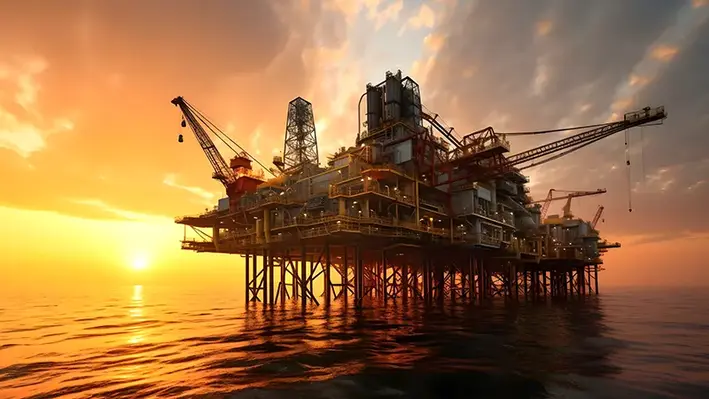
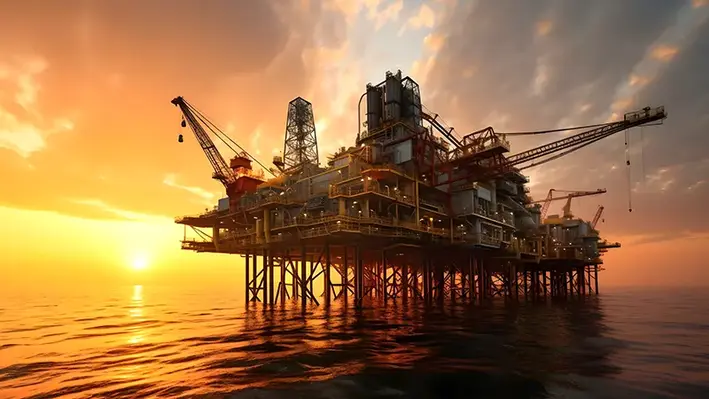
To help the world transition to net zero, decommissioned oil and gas platforms can be repurposed into green energy hubs.
This includes offshore rigs for carbon capture and storage or storing and transporting hydrogen, a type of sustainable fuel that doesn’t emit carbon when it is burned. A report published on the World Economic Forum suggested using legacy oil platforms to produce green hydrogen, which is generated using renewable energy.
Scientists have said that resusing depleted oil and gas wells would allow operators to access geothermal heat in hot rock formations, eliminating upfront costs of drilling new wells and potentially making the technology more appealing to the industry.
Moreover, researchers have suggested that repurposing depleted oil and gas wells may significantly help mitigate potential environmental impacts of abandoned wells and allow operators to access geothermal heat in underground rock formations. It also provides new job opportunities in areas with rich energy industry traditions.
According to Arash Dahi Taleghani, professor of petroleum and natural gas engineering at Penn State, using existing wells can help maintain employment in the area while also allowing communities to be part of the energy future.
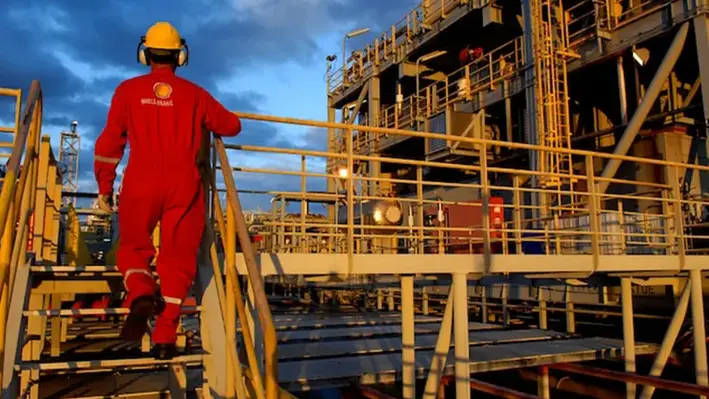
 Shell Brasil Petroleo Ltd has reached a final investment decision (FID) with Modec Inc for a floating production storage and offloading (FPSO) vessel to be deployed at the Gato do Mato oil field, offshore Brazil.
Shell Brasil Petroleo Ltd has reached a final investment decision (FID) with Modec Inc for a floating production storage and offloading (FPSO) vessel to be deployed at the Gato do Mato oil field, offshore Brazil.
The partners have a purchase and sales agreement that allows Modec to cover operations and maintenance of the FPSO for a period of 20 years with Shell. This follows the front-end engineering design (FEED) contract in March 2024 that has already been delivered.
The new agreement makes Modec responsible for the design of the hull and all related topsides facilities for the FPSO before mooring it with the help of a Sofec Spread Mooring system. Once moored at a water depth of approximately 2,000m, around 200km South of Rio de Janeiro, FPSO Gato do Mato will be capable of producing 120,000 barrels of oil per day (bopd), as well as associated gas and water. The produced stabilized crude will be stored in the FPSO tanks, and the oil will be offloaded to shuttle tankers to go to market.
Modec's 19th project in Brazil and the second for Shell, the FPSO Gato do Mato will feature a new built, custom-made next generation hull, designed on the basis of a 25-year shelf life.
The FPSO Gato do Mato will be the 19th FPSO to be developed by MODEC for Brazil. It will be the second unit to be delivered directly to Shell by MODEC for operation in Brazil.
The FPSO agreement comes soon after Shell took the FID for Gato do Mato, a deep-water project in the pre-salt area of the Santos Basin, offshore Brazil.
The Gato do Mato Consortium includes Shell (operator with a 50% stake), Ecopetrol (30%), TotalEnergies (20%) and Pré-Sal Petróleo S.A. (PPSA) acting as the manager of the production sharing contract (PSC). It is said that the estimated recoverable resource volumes from the site can reach upto 370 mn barrels.
“Gato do Mato is an example of our ongoing investment in increasingly efficient projects,” said Zoe Yujnovich, Shell’s Integrated Gas and Upstream Director. “The project contributes to maintaining stable liquids production from our advantaged Upstream business, and expands our leadership as the largest foreign producer in Brazil as we continue working to provide for the world’s energy needs well into the future.”
The consortium anticipates that the Gato do Mato field will commence operations in 2029.
Cilck here to know more about Offshore Network's events in Latin America.

 Aquaterra Energy, a leading provider of offshore engineering solutions, has secured a multi-million-dollar, multi-year contract with Intrepid Energy Limited (IEL) to supply a tailored subsea well intervention equipment package for a project in Nigeria
Aquaterra Energy, a leading provider of offshore engineering solutions, has secured a multi-million-dollar, multi-year contract with Intrepid Energy Limited (IEL) to supply a tailored subsea well intervention equipment package for a project in Nigeria
The turnkey well access system will enable IEL to conduct intervention operations across multiple mature oil wells, enhancing reservoir production.
The contract covers a complete seabed-to-surface intervention package, including Aquaterra Energy’s TRT tieback tooling for production bore and annular access, a lightweight well pressure control system, and an ISO 13628-7 qualified open water intervention riser with an integrated tensioning system. In addition to supplying the equipment, Aquaterra Energy will provide ongoing offshore engineering support throughout the project.
Designed for deployment from jack-ups and lift boats, the 7-3/8” lightweight well access solution offers a cost-effective and operationally efficient alternative to floating vessels, reducing intervention costs while maintaining safety and performance standards.
Andrew McDowell, Delivery Director at Aquaterra Energy, stated, “Our expertise in offshore engineering allows us to develop tailored intervention solutions that address the operational challenges of subsea well access. This system has been engineered for efficiency, ease of deployment, and safety, helping IEL optimise intervention activities across Nigeria while reducing costs. By delivering a complete, integrated package, we are simplifying complex operations and enabling operators to maximise production potential.”
Engr Seun Alonge, CEO at Intrepid Energy Limited, added, “Working with Aquaterra Energy marks a significant step forward for our intervention operations in Nigeria. Their specialised technology enhances our ability to execute intervention programmes efficiently, maximising performance across our assets. By combining Aquaterra’s technical expertise with our deep understanding of the local operating environment, we’re confident this collaboration will enhance production outcomes and create lasting value for our operations in the region.”
The project is set to span multiple years, with Aquaterra Energy providing continuous technical support through a dedicated team of engineers.
George Morrison, CEO at Aquaterra Energy, commented, "Delivering reliable and efficient well access solutions for shallow water subsea operations is central to how we support offshore operators. This collaboration with IEL reinforces our commitment to providing cutting-edge engineering solutions that enhance efficiency and reduce operational costs. With West Africa playing an important role in the global energy sector, we’re proud to continue supporting its offshore industry with our expertise and innovative technologies.”
Page 26 of 109